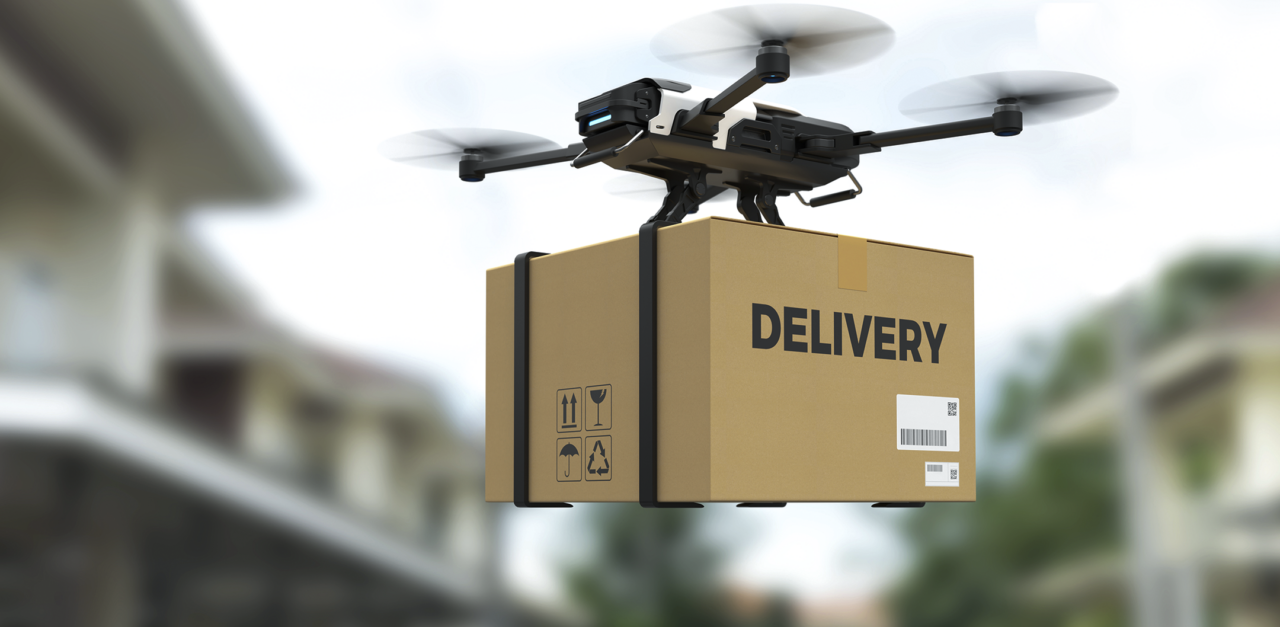At the FedEx distribution hub in North Carolina (USA), Jefe starts his work in the morning always strictly on time. He is in charge of loading heavier items – tires, canoes and boxes with the size of a safe – across more than 195 thousand square meters in the facility, where other 1,300 employees punch the clock daily. Jefe is never late. Jefe doesn’t rest. Jefe doesn’t complain about the salary. Jefe is actually a robot..
Jefe is part of a fleet of five autonomous equipment on wheels working at the site since 2018. It was developed to integrate the innovation program of this American company and designed to optimize processes inside its distribution hubs. Similarly to FedEx, other global big companies have increasingly invested in state-of-the-art technology to digitize the supply chain and their platforms for reception, storage and shipping of products, aiming at efficiency and cost reduction. It is the so-called Logistics 4.0, which is essential to raise competitiveness and ensure the future of companies in the digital economy age.
The push of e-commerce
The alliance between technology and logistics has been growing for decades, but it was with the recent explosion of e-commerce that this industry became strategic. According to the consulting firm eMarketer, global online trade revenue was US$4.28 billion in 2020 – 27% higher than in the previous year, reflecting already the impact of the pandemic and the lockdown, when physical stores had to close, accelerating the retail digitizing process.
Brazil is among the 10 largest global e-commerce markets – the largest in Latin America. In the first half of 2021 alone R$53.4 billion in goods and services were sold via websites or apps (Source: Nielsen), a record and an increase of 31% in relation to the first six months of the past year. 42 million Brazilians bought online, and 6.2 million were new users.

Given this phenomenon, it is not difficult to understand the needs that have led to an exponential increase in investments in technology solutions for the logistics area. Last August, the e-commerce company Mercado Livre announced investments of R$10 billion this year, mostly to improve its distribution systems.. This company sells 29 products per second and has eight distribution hubs in Brazil.
The e-commerce growth has pressured the logistics industry to become more efficient, as tolerance for delivery failures or delays is increasingly lower. But the issue goes beyond a simple improvement in the transport of goods. It involves integrating various operations: order management, checking of suppliers and partners, inventory control, monitoring of product movement – in and out of warehouses. In the face of this complexity, technology takes on a fundamental role.
READ MORE: Por que é a hora de investir na alta disponibilidade dos ambientes de TI ?
From blockchain to drones
Many technology solutions have already been used to gain agility, productivity and security in logistics 4.0. Some of them are not new, as in the case of radio frequency (RFID), which has long been used for communication between carriers and logistics warehouses. Monitoring of cargo by satellite (GPS) has also often been used by the industry for a long time – although the accuracy of devices has greatly enhanced in recent years.
Even the use of social networks is increasing and became relevant, as it helps and strengthens the relationship between companies and customers involving issues related to the delivery of goods.
But when it comes to ensuring greater security to large contracts and processes, the innovation is the use of blockchain. The technology that allows distributed data storage as an “immutable memory” ensures that the information recorded in it is not altered without the consent and knowledge of the other members of the chain. This is a great advantage, especially in logistics processes in which many parties are involved at the same time. A certificate of mutual digital trust that is much less expensive.
A good example of this application is the transport of sensitive cargoes, such as medical and pharmaceutical supplies, which require strict 24/7 monitoring of temperature conditions throughout their transport. By means of sensors installed in the materials shipped, it is possible to record these data using blockchain permanently, which can be used as a valuable consultation and legal security tool, when goods are delivered to the recipient.
he “last mile” challenge
Anyone who has monitored the delivery of an order in real time – for instance, of a pizza – and saw the app message “Ready for delivery” knows that the actual delivery of the order could take forever. This anxiety is part of the so-called “last mile“, the final moment of the delivery process and an issue that causes great tension – and cost – for the entire logistics chain.
This is because it involves a number of factors that could generate inefficiency. In cities, for example, traffic is an issue that must be considered, as well as narrow streets in districts not easily accessible, which makes the operation more difficult. In the countryside, the distance between points of delivery could be the factor that drives the final freight cost up.
A way to reduce the negative impact of this stage is to use technologies that combine IoT and geolocation to make the deliveries using drones and autonomous vehicles. Once the order is addressed, it is delivered to pick-up points that use small driverless equipment, which would bring the order to the buyer or the appropriate sector within a distribution hub – as Jefe does.
FedEx, by the way, developed in 2019 an autonomous hyperlocal delivery vehicle, the Roxo. With the size of a small refrigerator on six wheels, the ‘same day bot’ uses sensors and satellite-guided equipment to go from point A to point B. After periods of tests in small towns in the United States and England, Roxo was approved for large-scale use. Currently, six US states have already authorized its use for delivery of goods within a restricted distance radius.
READ MORE: Tecnologia IoT: eficiência e transformação
As for the use of drones, the first tests have already been made, but due to the characteristics of this means and to the various legal requirements for its authorization, this solution should take a little longer to be implemented. The fact is that the use of these unmanned aerial vehicles with high onboard technology will be crucial for the delivery of goods and products in remote locations, with a strong appeal for humanitarian missions.

The internet of transportable things
Among the available technologies most used by this industry, IoT is no doubt on the top. The intelligent sensor ecosystem that integrates industries, companies, businesses and individuals has been widely used to provide data on physical assets – i.e. products – that require monitoring, either within a facility or in a plane, shipped to the other side of the planet.
The information transmitted in real time not only allows a more precise and reliable control over the goods transported, but also checks the efficiency of the process – for example, the average speed and quality of routes of a moving fleet. This multitude of data can also help create completely new businesses..
In addition to being important for cargo tracking and transport resource management – vehicle maintenance, calculation of routes and freight, traffic monitoring, fuel consumption and the entire travel security planning – the IoT architecture must add value to inventory management and better process control. To that end, its association with edge computing is an even more assertive strategy. Edge computing processes data where data is generated, speeding up response time and streamlining the work of this entire automated infrastructure.
According to the consulting firm BCG, from the company’s cash perspective, digitization of the supply chain has collaborated with an average 40% increase in profit margins of operations, using 20% less working capital and reducing total logistical costs by up to 50%.

Sustainability is priority
According to the international law, shipping companies must reduce by half their greenhouse gas emissions (940 million tons per annum) by 2050. This industry, which is responsible for 80% of movement of goods globally, produces 2% to 3% of all CO2 dumped in the atmosphere today. Some experts suggest that this percentage could reach 17% in three decades if they do nothing (Source: S&P Global Platts). Decarbonizing is, therefore, an absolute priority.
The transition to carbon zero would necessarily require the use of technology – whether for development of less polluting fuel, more aerodynamic design for vessels, or for the creation of more efficient thrusters..
Other measures could be taken on land, such as optimizing company operations. IoT, edge computing and machine learning systems could greatly contribute to improving the energy efficiency of the entire onshore infrastructure of companies. The adoption of digital platforms such as the digital twin, which creates digital simulations for models and strategies before their implementation in real life, helps analyze assets and project any costs relating to maintenance. This is important as it anticipates actions that will help reduce costs and extend the useful life of the equipment.
READ MORE: How has edge computing become essential for the industry 4.0?
Preparing human talent
At FedEx warehouses in North Carolina, Jefe and his four autonomous friends do a work equivalent to that of 25 human employees. The unit’s management ensures that no jobs have been lost since the new robot colleagues joined the company. On the contrary: their arrival led others to develop new skills, many of them related to the IT area, such as server maintenance, digital platform operation and data management. FedEx says that 100 new jobs are created in that distribution hub every month since Jefe’s arrival.
In Deloitte’s “Delivering Digital Talent” report, analysts say these technologies are creating new tasks or recombining several of them, streamlining the work. Thus, activities that were performed within knowledge silos – such as logistics planning, coordination and payment of freight – are now performed by one single employee, with the help of data obtained via IoT and processes consolidated in the blockchain. These employees in their new roles seek additional knowledge, which results in a valuable addition to the company’s value chain.
In any activity, the evolution of technology has been fundamental to stimulating the reinvention of methods and recycling knowledge. In logistics 4.0, this is not different: the application of technology breaks down old paradigms and creates new processes that allow more productivity, efficiency, security and agility to the industry and those using it. The benefit of this transformation is horizontal: for companies, which become more profitable; for workers, who gain skills; for the environment, which is better preserved; and for final customers at home, less anxious and more confident that their order will arrive on time and as agreed.



